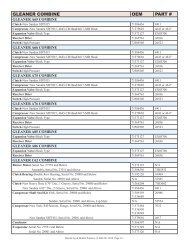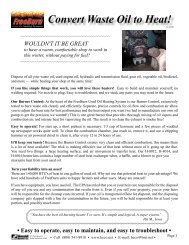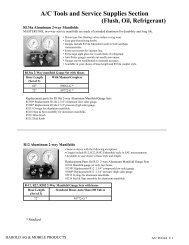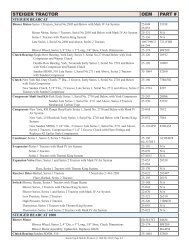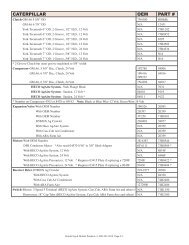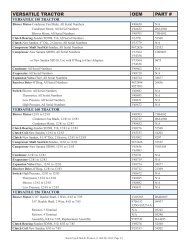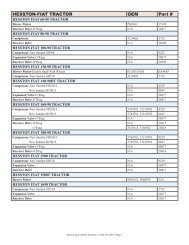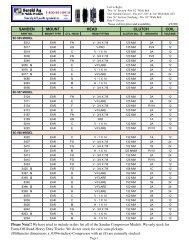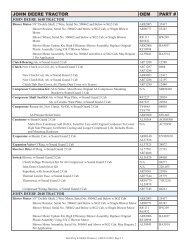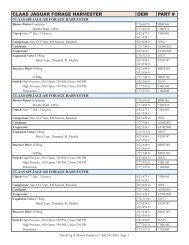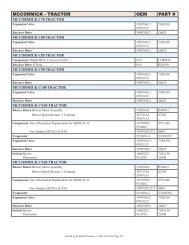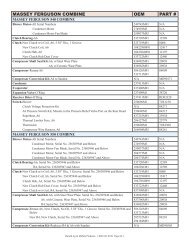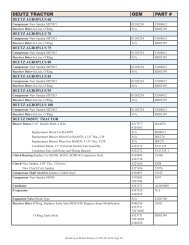COMPRESSOR CLUTCHES - Harold Electric Co.
COMPRESSOR CLUTCHES - Harold Electric Co.
COMPRESSOR CLUTCHES - Harold Electric Co.
Create successful ePaper yourself
Turn your PDF publications into a flip-book with our unique Google optimized e-Paper software.
<strong>COMPRESSOR</strong> <strong>CLUTCHES</strong><br />
8088<br />
GM-A6<br />
(Includes dust shield<br />
& rear coil seal)<br />
Sanden<br />
8311<br />
8450<br />
8470<br />
8440<br />
8455<br />
TEC-YORK-TCCI<br />
75R0452<br />
75R3502<br />
75R4502<br />
75R4534<br />
8295<br />
12431<br />
GM-A6<br />
(No coil see Pg B-9)<br />
SANDEN<br />
8306<br />
8462<br />
8464<br />
8465<br />
9575C<br />
9676C<br />
TEC-YORK-TCCI<br />
75R1202 HD<br />
Nippondenso<br />
600-3020<br />
600-3025<br />
SANDEN<br />
8297<br />
8298<br />
8299<br />
8411<br />
8412<br />
8420<br />
8425<br />
8435<br />
8445<br />
TEC-YORK-TCCI<br />
75R2552<br />
75R4652<br />
75R1802AM<br />
5063<br />
Nippondenso<br />
600-3007<br />
600-3013<br />
600-3017<br />
600-3000<br />
HAROLD AG & MOBILE PRODUCTS<br />
<strong>CLUTCHES</strong> B-1
<strong>CLUTCHES</strong><br />
Part No.<br />
Dia.<br />
No. of<br />
Grooves<br />
Groove<br />
Width<br />
Type of<br />
<strong>Co</strong>mp. Gauge Line Measurement (See A) Volts Notes <strong>Co</strong>mpressor Model<br />
600-9716 4 1/2" 4 Serp. Sanden N/A 12 V 3 8148<br />
8311 4 5/8" 7 Serp. Sanden 1 27/32" 12 V 2 4 5791<br />
8416 4 5/8" 8 Serp. Sanden N/A 12 V 3 7492<br />
8450 4 5/8" 6 Serp. Sanden 1 27/32" 12 V 3, 4 8026<br />
8470 4 5/8" 8 Poly Sanden 1 13/16" 12 V 3, 4 4711<br />
600-3025 4.9" 8 Serp. Nipp 1 3/16" 12 V N/A CO03120<br />
600-3040 4.9" 8 Serp. Nipp N/A 24 V 6 N/A<br />
600-3043 4.9" 8 Serp. Nipp N/A 24 V 7 CO03143, CO03121<br />
8411 5" 2 1/2 Sanden 1 9/16" 12 V 3 7851/7819<br />
8440 5" 6 Serp. Sanden 1 7/16" 12 V 3, 4 4600<br />
8462 5" 1 1/2" Sanden 1 9/16" 12 V 2 4504<br />
600-3060 5 1/8" 9 Serp. Nipp N/A 12 V 8 CO03290, CO03296<br />
600-9852 5 1/8" 8 Serp. Sanden 1 11/32" 24 V 3 4726<br />
600-3012 5 1/4" 1 1/2" Nipp N/A 24 V N/A CO031224/CO03161<br />
600-9003 5 1/4" 2 1/2" Sanden 1 9/16" 12 V 2, 6 5708<br />
8297 5 1/4" 2 1/2" Sanden 1 9/16" 12 V 2 8390/9103/9120<br />
8299 5 1/4" 2 1/2" Sanden 1 9/16" 24 V 2 8399/9105/9674<br />
8412 5 1/4" 2 1/2" Sanden 1 9/16" 12 V 3 4617<br />
8435 5 1/4" 2 1/2 Sanden 2 1/8" 12 V 3 4626<br />
8445 5 1/4" 2 1/2 Sanden 1 9/16" 12 V 3, 6 4664/4643<br />
8455 5 1/4" 8 Serp. Sanden 1 11/32" 12 V 3, 4 4637/4738<br />
600-3005 5 3/8" 2 1/2" Nipp N/A 12 V 6 CO03119<br />
8420 5 1/2" 2 1/2 Sanden 1 9/16" 12 V 3 8088<br />
8421 5 1/2" 2 1/2" Sanden 1 9/16" 12 V 3 7952<br />
8465 5 1/2" 1 1/2" Sanden 1 9/16" 12 V 3, 4 4604<br />
8088 (AM) 5 5/8" 1 1/2" GM-A6 N/A 12V 5 04005<br />
600-3020 5.7" 8 Serp. Nipp 1 13/32" 12 V N/A CO03140<br />
600-3000 (AM) 5 3/4" 1 1/2" Nipp 0.69" 12 V N/A CO03116<br />
600-3007 5 3/4" 1 1/2" Nipp 1/2" 12 V N/A CO03135<br />
600-3013 5 3/4" 1 1/2" Nipp 1/2" 12 V N/A CO03130<br />
600-3015 5 3/4" 1 1/2" Nipp N/A 24 V 7 CO03150<br />
600-3017 5 3/4" 1 1/2" Nipp 1 1/4" 12 V N/A CO03125<br />
600-3045 5 3/4" 8 Serp. Nipp N/A 24 V 7 CO03145<br />
8464 5 7/16" 1 1/2" Sanden 1 9/16" 12 V 3 4661<br />
600-3009 6" 1 5/8" Nipp N/A 12 V 7 10PA17C<br />
600-3014 6" 1 1/2" Nipp N/A 24 V N/A CO031226<br />
600-3018 6" 1 5/8" Nipp N/A 24 V N/A CO03124<br />
600-9851 6" 8 Serp. Sanden N/A 12 V 3 4768<br />
75R0452 6" 2 1/2" Tec/York 1 5/8" 12 V 1 N/A<br />
75R1202 6" 2 1/2" Tec/York 1 5/8" 12 V 1 N/A<br />
8295 6" 2 1/2" Tec/York 2 1/4" 24V 1 N/A<br />
8298 6" 2 1/2" Sanden 1 9/16" 12 V 2 8387/9571<br />
Note:1. These clutches come complete with 2 Row H.D. Bearing 2. For Sanden SD508, 510 <strong>Co</strong>mpressors 3. For 7H15 6. 2 wire<br />
4. (A) Measurement is from front mounting ear to center of poly V groove that is farthest from the front mounting ear. 5. With Dust <strong>Co</strong>ver<br />
(R) Remanufactured 6. For Nippondenson 10PA15C 7. For Nippondenso 10PA17C 8. For Nippondenso 7SBU16C<br />
<strong>CLUTCHES</strong> B-2 12/03/2013 1-800-541-8910
<strong>CLUTCHES</strong><br />
Part No.<br />
Dia.<br />
No. of<br />
Grooves<br />
Groove<br />
Width<br />
Type of<br />
<strong>Co</strong>mp. Gauge Line Measurement (See A) Volts Notes <strong>Co</strong>mpressor Model<br />
8306 6" 1 5/8" Sanden 1 11/32" 12 V 2 8478<br />
8425AM 6" 2 1/2 Sanden 1 9/16" 12 V 3 4609<br />
9675C 6 1/4" 1 1/2-3/4" Sanden 1 9/16" 12 V 2 9119/9675<br />
9676C 6 1/4" 1 1/2-3/4" Sanden 1 9/16" 24 V 2 9122/9676<br />
75R2552 6.7" 1 .60 Tec/York 3 1/8; 12 V N/A N/A<br />
75R3002 6 3/4" 1 1/2" Tec/York 2 3/4" 12 V<br />
75R1802AM 6 3/4" 1 5/8" Tec/York 2 3/4" 12 V N/A N/A<br />
75R3502 6 3/4" 2 1/2" Tec/York 2 1/4" 12 V 1 N/A<br />
12431 6 7/8" 1 1/2" GM-A6 N/A N/A No <strong>Co</strong>il 04008/04016<br />
75R4502 7" 2 1/2" Tec/York 2" 12 V N/A N/A<br />
75R4534 7" 2 1/2" Tec/York 2" 24 V Was 8296 N/A<br />
5063 7 3/8" 1 25/32" Tec/York 2" 12 V 1 N/A<br />
Note:1. These clutches come complete with 2 Row H.D. Bearing 2. For Sanden SD508, 510 <strong>Co</strong>mpressors 3. For 7H15 6. 2 wire<br />
4. (A) Measurement is from front mounting ear to center of poly V groove that is farthest from the front mounting ear. 5. With Dust <strong>Co</strong>ver<br />
(R) Remanufactured 6. For Nippondenson 10PA15C 7. For Nippondenso 10PA17C 8. For Nippondenso 7SBU16C<br />
Clutch Identification - For measuring Gauge Lines on <strong>Co</strong>mpressors<br />
For measuring clutch on and off vehicle with Tecumseh (Cast Iron)<br />
and York (Aluminum) <strong>Co</strong>mpressors.<br />
G.M. Frigidaire (A-6)<br />
A<br />
A= From face of rotor to midpoint<br />
of pulley groove<br />
A<br />
For measuring clutch on and off vehicle with Sanden <strong>Co</strong>mpressors<br />
A<br />
A<br />
HAROLD AG & MOBILE PRODUCTS<br />
<strong>CLUTCHES</strong> B-3
CLUTCH BEARINGS<br />
APPLICATION O.D. I.D. THICK PART NO.<br />
Clutch Bearing for Pitts, Ogura Clutches<br />
Wider Inner Race than Outside Race<br />
2 7/16" 1 3/16" 5/8" 10908<br />
Heavy Duty Pitts Clutches 2 7/16" 1 3/16" 1 1/16" 10909<br />
Visual <strong>Co</strong>mparison 8062, 8296, 04035, 04065 2 7/16" 1 3/16" 5/8" 10912<br />
Clutch Bearing for 10PA15, 10PA17, 10PA20,<br />
TV12C, TV12EC, TV12SC, TV14C, 10S17C<br />
Nippondenso <strong>Co</strong>mpressors<br />
Clutch bearing for John Deere Nippondenso<br />
6E171 Ear Mount <strong>Co</strong>mpressor, 50, 55, 60 Series<br />
Tractors<br />
2 3/64" 1 3/16" 7/8" 10913<br />
21/4" 1 1/2" 3/4" 10914<br />
GM Clutch A-6 2 7/16" 1 9/16" 13/16" 12589 (STD)<br />
12590 (HD)<br />
Sanden Clutches For SD5 <strong>Co</strong>mpressors 2 7/16" 1 9/16" 15/16' 52560<br />
Sanden Clutches For SD7 <strong>Co</strong>mpressors 2 5/32" 1 3/8" 25/32" 52565<br />
SANDEN CLUTCH PARTS<br />
Clutch No. Description Accessory Kit Bearing <strong>Co</strong>il Dust Shield Clutch<br />
8297 2GrA-12V-5 1/4" 54201 52560 54202 75R5005<br />
8298 2GrA-12V-6" 54201 52560 52976 75R5005<br />
8299 2GrA-24V-5 1/4" 54201 52560 52979 75R5005<br />
8300 2GrA-24V-6" 54201 52560 52980 75R5005<br />
8306 1GrB-12V-6" 54201 52560 52976 75R5005<br />
8307 1GrB-24V-6" 54201 52560 52980 75R5005<br />
8420 2GrV-12V-5 1/2" -- 52565 -- 36573<br />
9675C 1GrA-C12V-6 1/4" 54201 52560 52992 440-618<br />
9676C 1GrA-C24V-6 1/4" 54201 52560 52994 440-618<br />
8412 2GrA-12V-5 1/4" 52565 75R5112<br />
SD709 2GrA-24V-5 1/4" 52565 75R5114<br />
Sanden <strong>Co</strong>il Wires<br />
Black or Blue Wire 12 Volts<br />
Green Wire 24 Volts<br />
OTHER SANDEN COILS<br />
APPLICATION O.D. I.D. THICK PART NO.<br />
New 12 Volt <strong>Co</strong>il For Sanden SD508, SD510, With<br />
5.98" 2 Groove Sealed Clutch, with Dust Seal,<br />
2 wire<br />
4 3/64" 2 13/16" 1 1/2" 610-915<br />
New 12 Volt <strong>Co</strong>il For Sanden SD709, SD7H15, with<br />
5.98<br />
2 Groove Clutch, 2 Wire<br />
New 24 Volt <strong>Co</strong>il For SD709, SD7H15 with 4.92" and<br />
5.19"<br />
2 Groove Clutch<br />
4 3/64 2 13/16" 1 1/2" 610-985<br />
3.775" 2.525" 1 1/2" 610-972<br />
<strong>CLUTCHES</strong> B-4 12/03/2013 1-800-541-8910
CLUTCH HUB<br />
GM A6 Clutch Parts<br />
PART NO.<br />
All GM w/1 groove pulley -- 12197<br />
CLUTCH COIL<br />
12 V <strong>Co</strong>il-Flat Terminals 12417<br />
24 V <strong>Co</strong>il-Bullet Terminals -- 12420<br />
GM Clutch Dust shield -- 12440<br />
GM Rear <strong>Co</strong>il Seal -- 12445<br />
Bearing Seal Kit<br />
Fits A6 <strong>Co</strong>mpressors on agricultural applications -- 47251<br />
John Deere Nippondenso Clutch Parts<br />
DESCRIPTION<br />
PART NO.<br />
John Deere Ear Mount <strong>Co</strong>mpressor Clutch Dust <strong>Co</strong>ver 36574<br />
John Deere Direct Mount <strong>Co</strong>mpressor Clutch Dust<br />
<strong>Co</strong>ver 36577<br />
DESCRIPTION O.D. I.D. THICK PART NO.<br />
New 12 Volt <strong>Co</strong>il, 10PA17C,<br />
2 Wire 3.812" 2.435" 1.080" 610-300<br />
New 12 Volt <strong>Co</strong>il, 10PA15C,<br />
3 Wire 3.3/4" 2 1/2" 1 1/8" 610-305<br />
New 24 Volt <strong>Co</strong>il, 10PA17C,<br />
10PA15C 3.812" 2.435" 1.080" 610-310<br />
12401<br />
GM-A6<br />
Shaft Key<br />
York (CCI) Tecumseh<br />
<strong>Co</strong>mpressor Shaft Key<br />
Sanden <strong>Co</strong>mpressor<br />
Shaft Key<br />
7000 Series Allis Chalmers<br />
<strong>Co</strong>mpressor Belt Idler Pulley<br />
41241<br />
52545<br />
41243<br />
HAROLD AG & MOBILE PRODUCTS<br />
<strong>CLUTCHES</strong> B-5
Part No Price <strong>Co</strong>mment<br />
10908 $56.25<br />
10909 $35.00<br />
10912 $20.00<br />
10913 $40.00<br />
10914 $43.70<br />
12197 $40.00<br />
12401 $45.00<br />
12417 $49.95<br />
12420 $50.00<br />
12431 $250.00<br />
12440 $13.00<br />
12445 $1.00<br />
12589 $25.00<br />
12590 $0.00 R/B 12589<br />
36573 $25.00<br />
36574 $20.00<br />
36575 $30.00<br />
36577 $25.00<br />
41241 $0.75<br />
41243 $0.50<br />
47251 $0.00 N/A<br />
5063 $175.00<br />
52545 $0.75<br />
52560 $20.00<br />
52565 $15.00<br />
52976 $60.00<br />
52979 $40.00<br />
52980 $50.00<br />
52992 $50.00<br />
52994 $70.00<br />
54201 $6.50<br />
54202 $50.00<br />
600-3000 $275.00<br />
600-3000AM $125.00<br />
600-3005 $220.00<br />
600-3007 $160.00<br />
600-3009 $220.00<br />
600-3013 $175.00<br />
600-3015 $220.00<br />
600-3017 $220.00<br />
600-3020 $130.00<br />
600-3025 $200.00<br />
600-3040 $249.85<br />
600-3043 $225.00<br />
600-3045 $175.00<br />
600-3060 $150.00<br />
600-3100 $153.30<br />
600-9003 $200.00<br />
600-9716 $200.00<br />
600-9851 $200.00<br />
HECO CLUTCH PRICES<br />
Prices are Subject to change without notice<br />
Part No Price <strong>Co</strong>mment<br />
600-9852 $225.00<br />
610-300 $70.71<br />
610-305 $70.71<br />
610-310 $75.00<br />
610-915 $102.15<br />
610-985 $102.15<br />
75R0452 $111.35<br />
75R1202 $112.83<br />
75R2552 $211.38<br />
75R3502 $160.45<br />
75R4502 $135.28<br />
75R4534 $124.71<br />
75R4652 $0.00 R/B 5063<br />
75R5005 $24.81<br />
75R5006 $0.00 R/B 440-618<br />
75R5112 $78.35<br />
75R5114 $90.80<br />
8088 $200.00<br />
8088AM $75.00<br />
8088R<br />
$0.00 N/A<br />
8279 $475.00<br />
8295 $118.95<br />
8297 $100.00<br />
8298 $165.00<br />
8299 $150.00<br />
8306 $200.00<br />
8311 $100.00<br />
8411 $125.00<br />
8412 $130.00<br />
8416 $130.00<br />
8420 $250.00<br />
8421 $178.57<br />
8425AM $105.00<br />
8435 $200.00<br />
8440 $200.00<br />
8445 $150.00<br />
8450 $225.00<br />
8455 $225.00<br />
8462 $275.00<br />
8464 $233.75<br />
8465 $233.75<br />
8470 $125.00<br />
9676C $100.00<br />
CC10300 $60.00<br />
<strong>CLUTCHES</strong> B-6 12/03/2013 1-800-541-8910
Clutch Section<br />
high temperatures and high head pressure combine to<br />
whittle away at the reserve and we have a problem.<br />
811 W. Rose, Walla Walla, WA 99362<br />
Phone: (509)525-5070 Fax: (509)525-3753 1-800-541-8910<br />
www.heco.net | E-mail: heco@bmi.net<br />
(Article in portion is taken from IMACA Shop Talk)<br />
HOW TO AVOID CLUTCH PROBLEMS<br />
What are these applications problems that cause clutch<br />
failures? Clutch slippage is the most common complaint,<br />
but it's not always readily obvious why the clutch<br />
slips. Low voltage and high compressor demands are<br />
probably the most troublesome. Unfortunately, these<br />
can both be present at the same time.<br />
LOW VOLTAGE<br />
Low voltage has become chronic on many vehicles.<br />
Smaller batteries, and conductors, versus more electrical<br />
load, are draining the battery so that 9-11 volts is all<br />
that most clutches see, even on new vehicles! It's true<br />
we have decreased the engagement voltage on all 12<br />
volt clutches, so we're sure they will engage at 10 volts.<br />
This does not mean they will operate a compressor under<br />
severe conditions at 10 volts.<br />
OVERLOADING<br />
Excessive loads from the compressor comes from both<br />
over charging and loss of charge. High discharge pressure<br />
is generally the result of extremely high ambient<br />
temperatures. This added load on the clutch comes<br />
when the high temperature has caused the clutch current<br />
to drop as coil resistance increases. This begins to<br />
explain why most clutch complaints come about the<br />
end of July every year. We call this the July Syndrome.<br />
You would think that with the clutch capable of developing<br />
about two or three times the torque required to<br />
drive the compressor at normal conditions, there would<br />
never be a slipping problem. This is why we don't require<br />
clutch burnishing on most installations. A brand<br />
new clutch still will develop about 1-1/2 times the<br />
torque to drive the compressor and steadily improve as<br />
it is cycled until it reaches peak efficiency.<br />
The lower extra capacity of a new clutch, low voltage,<br />
HAROLD AG & MOBILE PRODUCTS<br />
OTHER PROBLEMS<br />
Other adverse conditions are rare, but still of interest<br />
and should be checked. Oil on the clutch face from<br />
leaking compressor seals has destroyed many clutches.<br />
Grease from the clutch bearing can do the same thing.<br />
A grease retainer is designed in the clutch to minimize<br />
this, as well as controlled specs on the grease fill in the<br />
bearing itself--but, it still can happen. Severe dust on<br />
"off-road" applications significantly shortens bearing<br />
life.<br />
Bearing failures can also be started from excess belt<br />
tension and from brinnelling upon installation to the<br />
shaft. When the clutch hub is placed off the key, sometimes<br />
a bolt will be run in forcing the key into the side<br />
of the hub. This causes hub expansion and bearing brinnelling.<br />
Obviously, the clutch won't turn without rubbing<br />
on the field coil, but even if it is corrected and the<br />
keyway lined up properly, the bearing may fail early.<br />
Incidentally, this "key-off" condition is a major cause<br />
of coil failure although the total numbers are very low.<br />
Many coil failures are really a result of excessive clutch<br />
slippage transferring heat to the coil face thus burning<br />
the potting compound and winding.<br />
When a compressor locks up, the clutch has to slip. This<br />
cause of failure is hard to analyze except by the technician<br />
who replaces both assemblies. A service report<br />
with the clutch can help in analyzing the conditions.<br />
Excessive vibration of the engine causes clutch failures.<br />
Some engines create a "G" force of 15 G's, or more,<br />
at the clutch. This may cause a rattle of the armature<br />
against the pulley when the clutch is disengaged. Usually,<br />
this happens at a high speed and it is not noticed<br />
when checking out an A/C unit in the shop. Driving a<br />
diesel truck down the highway all winter with the clutch<br />
rattling will wear the armature so that when it has to engage<br />
it has lost torque and slips. This rattling is also the<br />
cause of spring breakage, another rare occurrence, but<br />
when it happens there may be an epidemic. Six spring<br />
clutches are available to eliminate these problems.<br />
<strong>CLUTCHES</strong> B-7
TROUBLESHOOTING<br />
Some tips that will help the technician diagnose or prevent<br />
problems:<br />
1. One tool we recommend be available, and used regularly<br />
is a good voltmeter. Check the clutch voltage to<br />
ground when the system is operating; everything is on<br />
lights, engine running, fans, etc. If it's around 11 volts<br />
or less, better check some more installations. You may<br />
need an 11 volt clutch.<br />
2. When installing a clutch, be sure it seats on the shaft<br />
and key and use a torque wrench to properly torque the<br />
field coil and shaft bolts.<br />
3. Cycle a new clutch as much as practical after installation<br />
(as much as 200 cycles). This increases the torque<br />
greatly.<br />
4. On diesel engines and four-cylinder engines, run the<br />
engine speed up and down while watching the disengaged<br />
clutch.<br />
5. The cause of rubbing of the pulley on the field coil is<br />
often loose field coil screws. Elongated holes, broken<br />
tabs, etc. are the result of loose screws. These must be<br />
torqued as specified.<br />
In conclusion please remember, things are not always<br />
as they appear and just because a failure has occurred<br />
does not always justify blaming the part that failed.<br />
Two things happen in these rare cases. (1) The clutch<br />
torque decreases due to application problems, or (2) the<br />
compressor load increases. A normal clutch has about<br />
twice the torque capacity to drive a compressor under<br />
high load conditions. A normal clutch is one operating<br />
from a full 12 volts, cycling under a hood on a warm<br />
engine in fairly clean compressor installation. The normal<br />
compressor does not purge oil or operate over 350<br />
p.s.i.g. head pressure. These severe conditions can become<br />
more severe. The voltage can decrease, the temperature<br />
under the hood can increase, head pressure increase,<br />
etc. Even then, it is unlikely that a clutch would<br />
slip because of the safety factor built in.<br />
We believe that a combination of severe conditions<br />
must be superimposed, and our studies indicate this to<br />
be the case. <strong>Co</strong>nsider the following: Low voltage - a<br />
loss of 1 volt will drop torque 9%, 2 volts may cause<br />
partial engagement and drag. High temperature - a 50°F<br />
increase in temperature will drop torque 10%. A new<br />
clutch, before being cycled- has 1/3 less torque than after<br />
it is cycled for a few hours. Vibration such as from<br />
a diesel engine can cause severe wear, reducing torque<br />
drastically.<br />
More unusual causes' include low voltage feedback<br />
from permanent magnet blowers causing drag and wear<br />
of the clutch and reduced torque, oil from a compressor<br />
seal leak can reduce the friction drastically, and severe<br />
dust can destroy bearings and cause heat and slippage.<br />
SOME CAUSES OF BURNED <strong>CLUTCHES</strong><br />
When a clutch is removed from a compressor and set<br />
aside for examination, most of the clues to cause of<br />
failure are lost. A pulley assembly, separated from the<br />
coil and compressor, cannot yield as many clues as being<br />
able to analyze the application before it is removed.<br />
Nevertheless, we have searched out enough clues to establish<br />
a pattern in these "burned clutches".<br />
The usual explanation for a slipping clutch is "lack of<br />
torque." Of course, this is the obvious answer, as the<br />
clutch wouldn't slip if it transmitted more torque than<br />
the load. At the factory the clutch is torque tested after<br />
rigid inspection of face flatness, electrical characteristics,<br />
and dimensions of the magnetic paths. With all<br />
this, why do we still see some clutch failures?<br />
<strong>CLUTCHES</strong> B-8 12/03/2013 1-800-541-8910
Failed Mounting Flange Welds<br />
The field coil assembly consist of a field core that encloses the coil and a flange which is mounted to the compressor.<br />
The field core and flange are joined by resistance (spot) welds. Failure to those welds will cause rubbing<br />
between the field core and pulley, and eventually an open circuit and inoperative clutch.<br />
Open circuit in Field<br />
The field coil is held in the field core with an epoxy resin. If the bond between the epoxy and the field core fails,<br />
the coil may be allowed to move, which could lead to a break in the coil wire, and an inoperative clutch. With<br />
the exception of a fine crack around the outer diameter of the epoxy, there is no outward indication of a problem.<br />
However, the open circuit can be found with a resistance (ohm) meter.<br />
Bearing Failure<br />
Bearing failures can be caused by several factors. If the clutch slips severely due to the compressor slugging, the<br />
heat generated can cause the bearing to fail.<br />
Noisy Bearing<br />
If the complaint is noise related, a rough rotor bearing could be the source of the problem. Rough bearings can be<br />
felt when holding the armature hub stationary, and rotating the pulley. As with the failed bearing situation, several<br />
factors can cause a bearing to become rough. A rough bearing is one that may be in the early stages of failing<br />
completely. If the bearing is found to be rough, and there are no obvious signs that the problem was caused by<br />
factors other than the clutch.<br />
Failed Lead Wire<br />
If the lead wire connected to the field coil fails, the clutch becomes inoperative. While the cause of this failure is<br />
not definite, it may be due to a weak lead wire connection.<br />
Seized or Slugging <strong>Co</strong>mpressor<br />
The clutch's function is to engage and disengage the compressor from the vehicle's accessory drive system. If<br />
there is a problem that prevents the proper rotation of the compressor input shaft while the clutch is energized, the<br />
clutch will slip. The heat generated by the clutch slipping is tremendous, and in a matter of seconds components<br />
can start to fail. There is a progression of effect from slipping, leading up to overall clutch failure. These are listed<br />
below:<br />
A. Discoloration of Armature Assembly Disc-The extreme heat from slipping will quickly cause the disc to take<br />
on a discolored appearance. The disc will appear frosted.<br />
B. Melting of epoxy in Field <strong>Co</strong>il Assembly-The extreme heat may also effect the field coil, causing the epoxy<br />
to show signs of melting. Under extreme situations, the coil, which under normal circumstances is completely<br />
imbedded in the epoxy, will become exposed.<br />
C. The heat will eventually cause the bearing seals to melt, which allows the grease to escape. Without grease to<br />
lubricate the bearing, it soon fails completely.<br />
Leaking <strong>Co</strong>mpressor Input Shaft Seal<br />
A second clutch failure mode that can be attributed to a system problem is a failed bearing due to oil leaking from<br />
the compressor. This may occur if the seal on the compressor shaft leaks compressor oil, and it finds its way into<br />
the clutch rotor bearing. The oil may contaminate the bearing grease, causing it to be less effective, and also lead<br />
to grease purging through the bearing seals. The result is a gritty or failed bearing.<br />
<strong>Co</strong>mpressor Field Mounting Boss Dimensional Problem<br />
If there is a dimensional problem with the mounting bosses used for attaching the field coil assembly to the compressor,<br />
an interference condition may be created between the field coil and rotor assembly.<br />
HAROLD AG & MOBILE PRODUCTS<br />
<strong>CLUTCHES</strong> B-9
Re-machined <strong>Co</strong>mpressor Input Shaft<br />
During the course of re-manufacturing a compressor, the taper on the input shaft may be re-machined. As a result,<br />
the shaft will be shortened and less clearance will remain between the clutch and the compressor. This may create<br />
interference and hinder the rotation of the rotor assembly.<br />
Loose Field <strong>Co</strong>il Mounting Flange Bolts<br />
If the bolts used to mount the field coil are not tightened adequately, vibration in the vehicle will cause the mounting<br />
flange bolts to elongate. Eventually the field coil will begin to contact the rotor assembly, as evidenced by<br />
rubbing on the field coil outer diameter. This rubbing may generate heat that melts the field coil epoxy, leading to<br />
an open circuit and inoperative clutch.<br />
Short or Open Circuit in Field <strong>Co</strong>il Lead Wire<br />
If the clutch is installed on a vehicle in a way that the field coil lead wire rubs against something in the engine<br />
compartment, a short circuit or open circuit will likely develop over time that causes the clutch to become inoperative.<br />
This type of failure mode is evidenced by a lead wire worn down to bare metal in one or more locations<br />
along its length, or a lead wire that somehow gets cut in two while in the vehicle.<br />
Key Not Seated Properly in Armature Assembly Hub<br />
If the key and key ways of the compressor input shaft and armature hub are not lined up correctly during clutch<br />
installation, a severe misalignment of the armature and rotor assemblies relative to the shaft will occur. This misalignment<br />
will create interference between the rotor and field coil assemblies. Evidence of severe rubbing of the<br />
rotor on the field coil will be present.<br />
<strong>Co</strong>il Ground Wire Under Mounting Flange<br />
Some field coil assemblies have a ground wire terminal that is installed on the top of the coil mounting flange<br />
(this may require the use of a longer bolt). If the terminal is improperly installed under the flange, the coil will be<br />
cocked, and create the potential for rubbing between the rotor and coil assemblies.<br />
<strong>CLUTCHES</strong> B-10 12/03/2013 1-800-541-8910
FAILURE MODE SUMMARY CHART<br />
Ref. No. Failure Mode Armature Assembly Rotor Assembly Field <strong>Co</strong>il Assembly <strong>Co</strong>mments<br />
Clutch will probably be inoperative<br />
Mounting flange missing or starting to<br />
separate due to failed resistance (spot)<br />
welds<br />
No obvious problem Possibly some signs of the rotor<br />
rubbing on the field coil outer<br />
diameter<br />
1 Failed Field Mounting<br />
Flange Welds<br />
Outer diameter of field coil shows signs of<br />
rubbing<br />
Resistance check will show open<br />
circuit<br />
2 Open Circuit in Field <strong>Co</strong>il No obvious problem No obvious problem Possible small crack running along outer<br />
diameter of field coil epoxy<br />
Warranty analyst must distinguish<br />
this failure from seized or slugging<br />
compressor<br />
Possible some signs of rubbing on the<br />
outer diameter of the field coil<br />
Bearing either seized or tight<br />
Seals and balls may be missing<br />
3 Bearing Failure No obvious problem, especially<br />
no signs of severe heat exposure<br />
on disc<br />
4 Noisy Bearing No obvious problem Bearing feels "rough" No obvious problem Defective bearing -or- Leaking<br />
compressor seal caused bearing<br />
grease to purge<br />
5 Failed Lead Wire No obvious problem No obvious problem Missing lead wire Fatigue failure of connection -orimproper<br />
installation or damaged<br />
during removal<br />
HAROLD AG & MOBILE PRODUCTS<br />
Probably most frequent failure<br />
mode leading to warranty claims<br />
Epoxy shows signs of heat exposure,<br />
possibly exposing coil<br />
bearing seals melted or missing, grease<br />
purged<br />
Discloration on disc caused by<br />
heat from slipping<br />
6 Seized or Slugging<br />
<strong>Co</strong>mpressor<br />
bearing stiff or seized<br />
Rubber spacers on armature<br />
backing plate may be melted or<br />
missing<br />
<strong>Co</strong>mplaint may be due to noise or<br />
inoperative clutch from open circuit<br />
Some evidence of rubbing against rotor on<br />
O.D. and I.D. of field coil<br />
No obvious problem Bearing Ok, rotates smoothly<br />
7 <strong>Co</strong>mpressor Boss<br />
Dimension Problem<br />
Signs that the rotor has rubbed on field<br />
coil<br />
<strong>Co</strong>mplaint could be "seized" clutch<br />
Possibly some wear on top of field coil<br />
from contacting rotor<br />
No obvious problem Some wear on top of bearing bore<br />
pocket from contacting compressor<br />
bolts<br />
8 Re-Machined<br />
<strong>Co</strong>mpressor Input Shaft<br />
Field coil will probably have open<br />
circuit<br />
Mounting flange bolt holes elongated<br />
No obvious problem Possibly some signs of rubbing against<br />
field coil on inside of rotor<br />
9 Loose Field Flange<br />
Mounting Bolts<br />
O.D. and I.D. of field coil shows signs of<br />
rubbing against rotor<br />
<strong>Co</strong>mplaint may be erratic operation<br />
or inoperative clutch<br />
No obvious problem No obvious problem Insulation on lead wire worn down to bare<br />
metal in one or more spots<br />
10 Short/Open Circuit in<br />
Field <strong>Co</strong>il Lead Wire<br />
Lead wire may be severely kinked or cut<br />
<strong>Co</strong>mplaints may include inoperative<br />
clutch<br />
Evidence of severe rubbing against rotor<br />
on O.D. of field coil<br />
Some evidence of rubbing on I.D. of<br />
rotor<br />
Armature Hub is damaged in<br />
area of key way<br />
11 Key Not Sealed Properly<br />
in Armature Hub<br />
<strong>Co</strong>mplaints may include inoperative<br />
clutch<br />
Imprint of ground wire terminal on bottom<br />
side of mounting flange<br />
No obvious problem Some evidence of rubbing on field coil<br />
on I.D. of rotor<br />
12 <strong>Co</strong>il Ground Wire Under<br />
Mounting Flange<br />
<strong>CLUTCHES</strong> B-11<br />
Evidence of rubbing against rotor on O.D.<br />
of field coil
HECO CLUTCH CROSS REFERENCE NUMBERS<br />
OEM Cross X HECO PART # OEM Cross X HECO PART # OEM Cross X HECO PART #<br />
10761 5063<br />
AH79301 75R0452<br />
RD-5-4976-0 75R1802AM<br />
75R4652 5063<br />
C7AZ-2884-B 75R0452<br />
5037 75R1802AM<br />
502400 5063<br />
D5NN19D649A 75R0452<br />
10591 75R1802AM<br />
L50-2400 5063<br />
D8NN19D847AA 75R0452<br />
600-5038 75R1802AM<br />
2329091 5063<br />
RD-5-4967-0 75R0452<br />
47973 75R1802AM<br />
1MXA1279 5063<br />
274224 75R0452<br />
502736 75R1802AM<br />
1MXA3268 5063<br />
30-302345 75R0452<br />
V19107 75R1802AM<br />
CA-315 5063<br />
30-3353680 75R0452<br />
CL-0634 75R1802AM<br />
600-5045 5063<br />
3317V002 75R0452<br />
2329068 75R1802AM<br />
K332-25 5063<br />
332639 75R0452<br />
75R1802 75R1802AM<br />
K332-15 5063<br />
400-036 75R0452<br />
CA-314 75R1802AM<br />
RE10975 600-3000<br />
402400 75R0452<br />
600-5035 75R2552<br />
04027C 600-3000<br />
402918 75R0452<br />
274363M91 75R2552<br />
AH119048 600-3000<br />
600-5000 75R0452<br />
2329076 75R2552<br />
CA-157 600-3000AM 65338C91 75R0452<br />
A2211669 75R2552<br />
AZ48479 600-3005<br />
7020704 75R0452<br />
A-7677 75R3502<br />
CA-140 600-3005<br />
72540774 75R0452<br />
RD-5-10370-0 75R3502<br />
RE53408 600-3007<br />
904408 75R0452<br />
10795 75R3502<br />
RE58348 600-3013<br />
7531 75R0452<br />
1669746C91 75R3502<br />
5020 600-3013<br />
47531 75R0452<br />
17B013183 75R3502<br />
CA-145 600-3013<br />
D42H2981BA 75R0452<br />
17906 75R3502<br />
5017 600-3015<br />
86529809 75R0452<br />
31-1607760 75R3502<br />
CA-145-24V 600-3015<br />
25-029 75R0452<br />
502742 75R3502<br />
R128825 600-3017<br />
165338C91 75R0452<br />
47979 75R3502<br />
5018 600-3017<br />
1MX242 75R0452<br />
511199 75R3502<br />
CA146 600-3017<br />
ABPN83303002 74R1202<br />
MA-N01 75R3502<br />
CA-146 600-3017<br />
K332-14 74R1202<br />
2329083 75R3502<br />
RE52508 600-3020<br />
RD-5-5183-0 74R1202<br />
A2210795 75R3502<br />
CL-1776C 600-3020<br />
02-3002 74R1202<br />
A2222498 75R3502<br />
CL1776 600-3020<br />
031104973 74R1202<br />
425450C92 75R3502<br />
CA-143DS 600-3020<br />
10884 74R1202<br />
ZGG11565 75R3502<br />
AL78494 600-3025<br />
274226 74R1202<br />
1MXA1281 75R3502<br />
22-11303 600-3025<br />
30-3032345 74R1202<br />
11153 75R3502<br />
5022 600-3025<br />
3117v004 74R1202<br />
47908 75R3502<br />
CA-147 600-3025<br />
3918268 74R1202<br />
A-7685 75R4502<br />
AT221651 600-3040<br />
400-221 74R1202<br />
A-8534 75R3502<br />
CL003043 600-3043<br />
402044 74R1202<br />
A167419 75R3502<br />
5024 600-3043<br />
402915 74R1202<br />
A64956 75R3502<br />
CA-141-24V 600-3043<br />
433177 74R1202<br />
A55057 75R3502<br />
447100-5070 600-3043<br />
600-5002 74R1202<br />
A66058 75R3502<br />
4471005070 600-3043<br />
904326 74R1202<br />
A66077 75R3502<br />
CL003045 600-3045<br />
904327 74R1202<br />
D2NN19D649A 75R3502<br />
5023 600-3045<br />
165129C91 74R1202<br />
MA7A<br />
75R3502<br />
CA-143-24V 600-3045<br />
1647566C91 74R1202<br />
143405C91 75R3502<br />
CL003100 600-3100<br />
IMX240 74R1202<br />
600-5010 75R3502<br />
CL033100 600-3100<br />
18-01210 74R1202<br />
71159661 75R3502<br />
FONN19N688AA 600-9003<br />
47551 74R1202<br />
71182664 75R3502<br />
FONN19D649AA 600-3100<br />
47907 74R1202<br />
72084050 75R3502<br />
CL009716 600-9716<br />
k332-24 74R1202<br />
7534 75R3502<br />
87334407 600-9716<br />
501939 74R1202<br />
47534 75R3502<br />
403585A1 600-9716<br />
024-21590 74R1202<br />
1411-72 75R3502<br />
CL09852 600-9852<br />
A-8567 75R1802AM A162008 75R3502<br />
CLUTCH B-12 12/03/2013 1-800-541-8910
HECO CLUTCH CROSS REFERENCE NUMBERS<br />
OEM Cross X HECO PART # OEM Cross X HECO PART #<br />
603441 75R3502<br />
600-9005 8297<br />
134547C91 75R3502<br />
700709771 8297<br />
AH85847 75R3502<br />
72162176 8297<br />
25-160 75R3502<br />
CL-1005C 8297<br />
31-1819903 75R3502<br />
72215919 8297<br />
2329089 75R3502<br />
72262178 8297<br />
1411-44 75R3502<br />
01-3759 8297<br />
8296 75R4534<br />
SFD013764 8297<br />
501075 75R4534<br />
916199 8297<br />
MA7A 24V 75R4534<br />
3478416M91 8297<br />
2329090 75R4534<br />
837510M91 8297<br />
ABPN83303342 75R4534<br />
01-3764 8297<br />
1140568C91 75R4534<br />
V55302 8297<br />
22-11017 75R4534<br />
6519-6010 8297<br />
RD-5-8382-0 75R4534<br />
FONN19B649BA 8297<br />
600-1105 8088<br />
72162178 8297<br />
73-003S 8088<br />
1981779C1 8298<br />
AR71287 8088<br />
4327654 8298<br />
70256789 8088<br />
600-9006 8298<br />
533719M91 8088AM<br />
600-9008 8298<br />
7N4300 8088AM<br />
72085285 8298<br />
7N4401 8088AM<br />
83935C1 8298<br />
70269743 8088AM<br />
4338893 8298<br />
72-0038 8088AM<br />
8518-6012 8298<br />
4330737 8088AM<br />
CL-1025 8298<br />
8088R<br />
8088AM<br />
700712768 8298<br />
PB-501<br />
8088AM<br />
433893 8298<br />
ABPN83303212 8295<br />
1AF9ZNM 8299<br />
E-802592 8295<br />
600-9840 8306<br />
KA1275 8295<br />
SFD013761 8306<br />
K332-41 8295<br />
600-9700 8411<br />
RD-5-4964-0 8295<br />
71386436 8411<br />
02-3051 8295<br />
72276952 8411<br />
1-3304 8295<br />
9967658 8411<br />
400-390 8295<br />
1055450M91 8411<br />
402359 8295<br />
773299M92 8411<br />
4379-RD549690 8295<br />
CL-1010 8411<br />
501076 8295<br />
CL-1010C 8411<br />
75R0754 8295<br />
CA-206 8411<br />
904328 8295<br />
CL-1036C 8412<br />
5045 8295<br />
600-9835 8412<br />
22-11012 8295<br />
86001192 8412<br />
75R4734 8295<br />
22-04617 8412<br />
RD-5-9659-0 8295<br />
600-9710 8420<br />
MA6A-24 8295<br />
3902115M91 8412<br />
2329049 8295<br />
600-9709 8421<br />
MA61-2 8295<br />
CA-209 8425AM<br />
AR9676 8297<br />
600-9825 8435<br />
1-3759 8297<br />
600-9830 8440<br />
1069215M91 8297<br />
CL-1035 8440<br />
30-3373177 8297<br />
CL1035 8440<br />
509285 8297<br />
600-9705 8445<br />
HAROLD AG & MOBILE PRODUCTS<br />
OEM Cross X HECO PART #<br />
85817171 8445<br />
5064 8445<br />
CL-8104C 8445<br />
6511-6210 8445<br />
65116210 8445<br />
1081455M91 8445<br />
72507683 8445<br />
4639-9931 8445<br />
600-9845 8450<br />
82008824 8450<br />
82008826 8450<br />
82025334 8450<br />
600-9850 8455<br />
8600-2087 8455<br />
600-9815 8462<br />
CL-4661 8464<br />
600-9800 8464<br />
6590-6210 8464<br />
600-9765 8465<br />
6506-6010 8464<br />
CL-1047 8470<br />
600-9728 8470<br />
8460 8470<br />
600-9865 8470<br />
87334399 8470<br />
CL-1047C 8470<br />
600-9024 9676C<br />
CL-1007-24VC 9676C<br />
CL-1007-24V 9676C<br />
CLUTCH B-13



